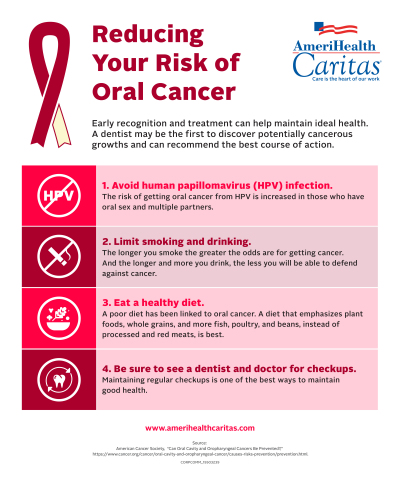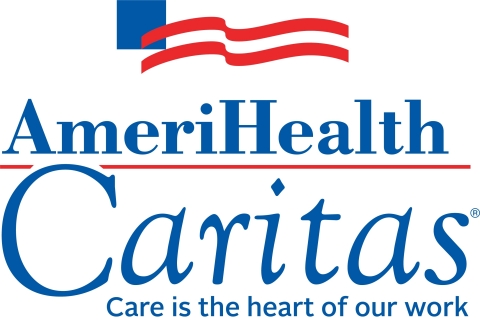PHILADELPHIA--(BUSINESS WIRE)--An emerging new type of oral cancer in men has increased over the last 15 years.1 The culprit is human papillomavirus (HPV), and key social factors are contributing to its growth. April is Oral Cancer Awareness Month, and with the ongoing rise in cases of throat cancer linked to HPV,2 many medical and dental professionals are encouraging the public to take measures in an effort to help prevent this form of cancer.
The prevalence of oral HPV in men in the U.S is estimated to be more than 11 million—much higher than previously believed.3 “While women often clear HPV and can get regular pap smears to diagnose their HPV, there is no screening test for men,” said Nathan Fletcher, DDS, a dental director at AmeriHealth Caritas who closely studies oral diseases relative to people of color. “That is one reason the death rate associated with oral and oropharyngeal cancers for men remains high – these cancers often are discovered too late.” In the case of HPV-related throat cancer – which actually surpasses the annual incidence rate for cervical cancer — men outpace women by 4-1.4
HPV is believed to be the cause of 70 percent of throat cancer in the United States.5 Approximately 11,000 people, or 4.8 percent who contract the disease, will die from it this year.6 These cancers are more likely for some racial and ethnic groups, and are also impacted by socioeconomic status.7
According to the Centers for Disease Control and Prevention (CDC), the five-year survival rate for oral cancer is about 61 percent for whites, but only 36 percent for African Americans.8 “Socio-economic factors are often connected to poor oral health as they hinder one’s ability to be able to afford and keep dental insurance, or pay out of pocket to see their dentist regularly, a critical factor in maintaining proper oral health,” said Andrea Gelzer, MD, MS, FACP, senior vice president of Medical Affairs for AmeriHealth Caritas. “Other factors such as limiting tobacco and alcohol use, maintaining a healthy diet and making sure to have regular health screenings all may help prevent oral cancer, or to catch it early enough so that it may be treated.”
“Early detection is critical, said Larry Paul, DDS, vice president Corporate Dental at AmeriHealth Caritas. “Visiting the dentist for regular x-rays, exams and cleanings has always been recommended, but today those visits are crucial for facilitating overall health. It also speaks to the importance of the integration and collaboration of medical and dental providers in creating solutions for a serious health problem.”
While not all oral cancers can be prevented, there are ways to reduce the risk:9
-
Avoid human papillomavirus infection.
HPV is strongly associated with oropharyngeal cancers. The risk of getting oral cancer from human papillomavirus is increased in those who have oral sex and multiple partners. The CDC recommends that all children who are 11 or 12 years old should get two shots of HPV vaccine six to 12 months apart before they become sexually active.10 -
Limit smoking and drinking.
Smoking increases the risk of getting oral cancer. The longer one uses tobacco, the greater the odds are for getting cancer. Smokeless tobacco carries a risk as well. Limiting alcohol is also a great way to reduce the risk of getting oral cancer. -
Eat a healthy diet.
A poor diet has been linked to oral cancer. The American Cancer Society recommends a diet that emphasizes plant foods, whole grains and more fish, poultry and beans, instead of processed and red meats, is best. -
Be sure to see a dentist and doctor for check ups.
Maintaining regular checkups is one of the best ways to maintain good health.
About AmeriHealth Caritas Family of Companies
AmeriHealth
Caritas is one of the nation’s leaders in health care solutions for
those most in need. Operating in 11 states and the District of Columbia,
AmeriHealth Caritas serves more than 5 million Medicaid, Medicare and
Children’s Health Insurance Program (CHIP) members through its
integrated managed care products, pharmaceutical benefit management and
specialty pharmacy services, and behavioral health services.
Headquartered in Philadelphia, AmeriHealth Caritas is a mission-driven
organization with more than 35 years of experience serving low-income
and chronically ill populations. AmeriHealth Caritas is part of the
Independence Health Group in partnership with Blue Cross Blue Shield of
Michigan. For more information, visit www.amerihealthcaritas.com.
1 Dermatology Times. “The rise of oral cancer. “Accessed Feb. 22, 2019. https://www.dermatologytimes.com/dermatology/rise-oral-cancer
2 Centers for Disease Control and Prevention. Genital HPV Infection – Fact Sheet. Accessed Feb. 6, 2019. https://www.cdc.gov/std/hpv/stdfact-hpv.htm
3 The Oral Cancer Foundation. “Oral Cancer News.” Accessed Feb. 6, 2019. https://oralcancernews.org/wp/the-rise-of-hpv-related-cancers-in-men/
4 Study Finds. “Growing threat to Men? Study Finds 45% Of Adults Males Infected With HPV.” Accessed March 11, 2019. https://www.studyfinds.org/hpv-cancer-std-men-study
5 Centers for Disease Control and Prevention. “HPV and Oropharyngeal Cancer.” Accessed March 8, 2019. https://www.cdc.gov/cancer/hpv/basic_info/hpv_oropharyngeal.htm
6 American Cancer Society. “Key Statistics for Oral Cavity and Oropharyngeal Cancers.” Accessed Feb. 6, 2019. https://www.cancer.org/cancer/oral-cavity-and-oropharyngeal-cancer/about/key-statistics.html
7 Centers for Disease Control and Prevention. “Oral Health.” Accessed Feb. 6, 2019. https://www.cdc.gov/oralhealth/oral_health_disparities/index.htm
8 Centers for Disease Control and Prevention. “Oral Health.” Accessed Feb. 6, 2019. https://www.cdc.gov/oralhealth/oral_health_disparities/index.htm
9 American Cancer Society. “Can Oral Cavity and Oropharyngeal Cancers Be Prevented?” Accessed Feb. 6, 2019. https://www.cancer.org/cancer/oral-cavity-and-oropharyngeal-cancer/causes-risks-prevention/prevention.html
10 CDC. “HPV Vaccines: Vaccinating Your Preteen or Teen.” Accessed March 25, 2019. https://www.cdc.gov/hpv/parents/vaccine.html




